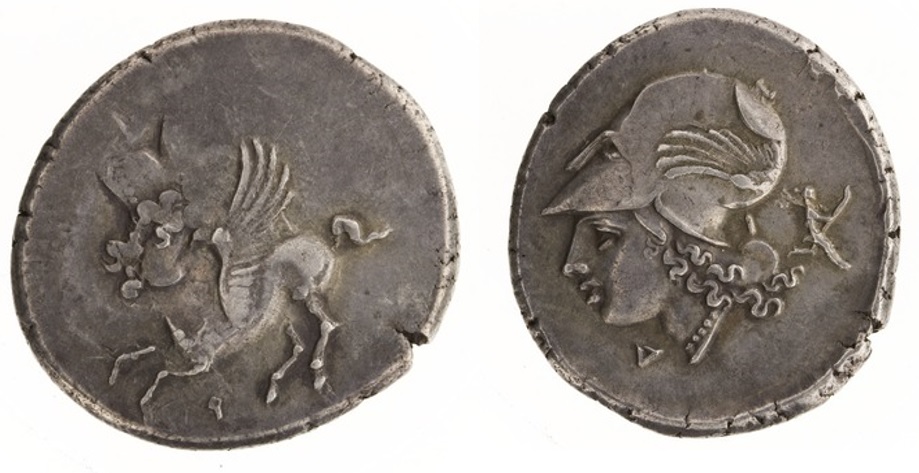3580 - Corinth (stater Pegasus/Athena) over Corinthian type (Pegasus/Athena) (New York, ANS, 1968.57.45)
From SILVER
m (Carrier moved page SO 5 - Corinth over uncertain mint to SO 5 - Corinth over uncertain mint (New York, ANS, 1968.57.45)) |
|||
| Line 14: | Line 14: | ||
|Axis=1 h | |Axis=1 h | ||
|Denomination=stater | |Denomination=stater | ||
| − | |Coin series reference= | + | |Coin series reference=HGC 4, n° ? |
|Overstruck obverse description=visible on obverse: Hair? | |Overstruck obverse description=visible on obverse: Hair? | ||
|Frequency of overstrikes=exceptional | |Frequency of overstrikes=exceptional | ||
|Level of confidence=uncertain | |Level of confidence=uncertain | ||
}} | }} | ||
Revision as of 00:56, 5 December 2022
386 - 307Ϙ
Location/history
| Museum collectionMuseum collection: | New York, American Numismatic Society, 1968.57.45 | |
Overstriking coin
Description
| ObverseInscription or printing placed on the obverse.: | Ϙ Pegasus flying left. | ReverseInscription or printing placed on the reverse.: | Head of Athena left, wearing a necklace and Corinthian helmet. In field, Δ and monogram. |
Mint and issuing power
| MintIdentifies the place of manufacture or issue of a numismatic object.: | Corinth | Ancient regionAncient region. | Peloponnesus | Modern countryModern country: Greece | AuthorityIdentifies the issuing power. The authority can be "pretended" when the name or the portrait of X is on the coin but he/she was not the issuing power. It can also be "uncertain" when there is no mention of X on the coin but he/she was the issuing power according to the historical sources: |
Chronology
| FromIdentifies the initial date in a range assigned in a numismatic context. 386 toIdentifies the final date in a range assigned in a numismatic context.. 307 | Classical 480-323 BC |
Physical description
| MetalThe physical material (usually metal) from which an object is made.: Silver |
WeightWeight of the numismatic object (in grams). in grams: 8.58.5 g <br />8,500 mg <br /> | DenominationTerm indicating the value of a numismatic object. Examples: tetradrachm, chalkous, denarius.: stater |
AxisDescribes the directional relationship between the obverse and reverse of a numismatic object.: 1 h"h" is not declared as a valid unit of measurement for this property. |
References
| Coin referenceReference of the Coin: | Coin series referenceReference to coin series study: | HGC 41HGC 4, n° ? |
Overstruck type
Description
| ObverseInscription or printing placed on the obverse.: | visible on obverse: Hair? | ReverseInscription or printing placed on the reverse.: |
Mint and issuing power
| MintIdentifies the place of manufacture or issue of a numismatic object. ᵖ: | Ancient regionAncient region. ᵖ | Modern countryModern country: | AuthorityIdentifies the authority in whose name (explicitly or implicitly) a numismatic object was issued. ᵖ: |
Chronology
| FromIdentifies the initial date in a range assigned in a numismatic context. toIdentifies the final date in a range assigned in a numismatic context.. | periodTime period of the numismatic object. |
Physical description
References
| Coin type referenceReference to coin series study ᵖ: |
Additional data
| Frequency of overstrikesFrequency of overstrikes: | exceptional | Level of confidenceLevel of confidence of the identification: | uncertain |
| RemarksRemarks: | |||
References
- ^ Hoover, Oliver D. (2014), Handbook of Greek Coinage Series 4. Northern and Central Greece : Achaia Phthiotis, Ainis, Magnesia, Malis, Oita, Perrhaibia, Thessaly, Akarnania, Aitolia, Lokris, Phokis, Boiotia, Euboia, Attica, Megaris and Corinthia, sixth to first centuries BC, Lancaster, lxxi, 563 p.
